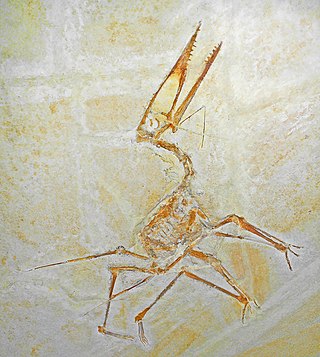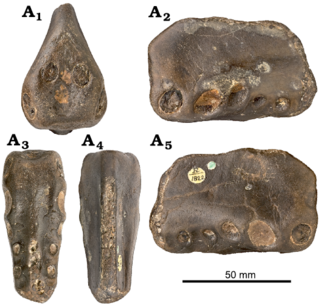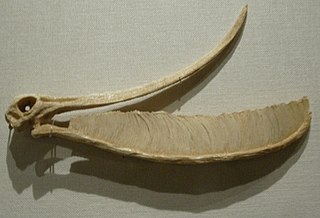
This phylogeny of pterosaurs entails the various phylogenetic trees used to classify pterosaurs throughout the years and varying views of these animals. Pterosaur phylogeny is currently highly contested and several hypotheses are presented below.

This phylogeny of pterosaurs entails the various phylogenetic trees used to classify pterosaurs throughout the years and varying views of these animals. Pterosaur phylogeny is currently highly contested and several hypotheses are presented below.
The matrix includes 19 pterosaur groups (most of which are supra-specific) plus a single outgroup (Euparkeria capensis). The taxa were coded for 60 characters.
The matrix includes 39 valid pterosaur species, although Rhamphorhynchus longicaudus and Nyctosaurus bonneri are usually considered to be synonymous with R. muensteri and N. gracilis respectively, plus a three outgroup species ( Ornithosuchus longidens , Herrerasaurus ischigualastensis and Scleromochlus taylori ). The taxa were coded for 74 characters.
| Pterosauria |
| |||||||||||||||||||||||||||||||||||||||||||||||||||||||||||||||||||||||||||||||||||||||||||||||||||||||||||||||||||||||||||||||||||||||||||||||||||||||||||||||||||||||||||||||||||||||||||||||||||||||||||||||||||||
In 2010, Brian Blake Andres wrote a review of pterosaur phylogeny in his dissertation. His phylogenetic analysis combined data mainly from three different matrixes: Kellner's original analysis (2003) and its updates (Kellner (2004), Wang et al. (2005) and Wang et al. (2009)), Unwin's original analysis (2003) and its updates (Unwin (2002), Unwin (2004), Lu et al. (2008) and Lu et al. (2009)) and previous analyses by Andres et al. (2005), Andres and Ji (2008) and Andres et al. (2010). Additional characters are taken from DallaVecchia (2009), Bennett' analyses (1993–1994) and various older, non-phylogenetic, papers. [2]
The matrix includes 100 valid pterosaur species plus a single outgroup ( Euparkeria capensis ). This represents 70.4% of 142 known pterosaur species back then. These were scored for 183 morphological characters (compared to 3 outgroups plus 57 ingroups which were scored for 89 characters of Wang et al. 2009 [the latest version of Kellner's analysis] and to 1 outgroups plus 59 ingroups which were scored for 117 characters of Lu et al. 2012 [the latest version of Unwin's analysis]). [3] The resultant topology is well supported and more resolved than previous analyses. Furthermore, it codes only species as terminal taxa, (unlike some analyses, e.g., Unwin (2003) who used mainly families) and uses the holotype specimens for the codings (unlike some analyses, e.g., Kellner (2003)). [2] This phylogenetic analysis was used by Richard J. Butler, Stephen L. Brusatte, Brian B. Andres and Roger B. J. Benson (2012) to assess the morphological diversity and fossil sampling biases of the Pterosauria. [3] A paper focusing on the pterosaur phylogeny (Andres) was published in a book named "The Pterosauria". [4] An updated and more resolved version of this phylogeny was published formally by Andres and Timothy Myers in 2013, containing 185 characters and 109 ingroup taxa. Below is a cladogram showing these results after the exclusion of three taxa that can be coded only for one character (clade names follow Andres & Myers, 2013). [5]
| Pterosauria |
| |||||||||||||||||||||||||||||||||||||||||||||||||||||||||||||||||||||||||||||||||||||||||||||||||||||||||||||||||||||||||||||||||||||||||||||||||||||||||||||||||||||||||||||||||||||||||||||||||||||||||||||||||||||||||||||||||||||||||||||||||||||||||||||||||||||||||||||||||||||||||||||||||||||||||||||||||||||||||||||||||||||||||||||||||||||||||||||||||||||||||||||||||||||||||||||||||||||||||||||||||||||||||||||||||||||||||||||||||||||||||||||||||||||||||||||||||||||||||||||||||||||||||||||||||||||||||||||||||||||||||||||||||||||||||||||||||||||||||||||||||||||||||||||||||||||||||||||||||||||||||||||||||||||||||||||||||||||||||||||||

Eudimorphodon was a pterosaur that was discovered in 1973 by Mario Pandolfi in the town of Cene, Italy and described the same year by Rocco Zambelli. The nearly complete skeleton was retrieved from shale deposited during the Late Triassic, making Eudimorphodon one of the oldest pterosaurs known. It had a wingspan of about 100 centimeters (3.3 ft) and at the end of its long bony tail may have been a diamond-shaped flap like in the later Rhamphorhynchus. If so, the flap may have helped it steer while maneuvering in the air. Eudimorphodon is known from several skeletons, including juvenile specimens.

Anurognathidae is a family of small, short-tailed pterosaurs that lived in Europe, Asia, and possibly North America during the Jurassic and Cretaceous periods. Five genera are known: Anurognathus, from the Late Jurassic of Germany; Jeholopterus, from the Middle to Late Jurassic of China; Dendrorhynchoides, from the Middle Jurassic of China; Batrachognathus, from the Late Jurassic of Kazakhstan; and Vesperopterylus, from the Early Cretaceous of China. Bennett (2007) suggested that the holotype of Mesadactylus, BYU 2024, a synsacrum, belonged to an anurognathid, though this affinity has been questioned by other authors. Mesadactylus is from the Late Jurassic Morrison Formation of the United States. Indeterminate anurognathid remains have also been reported from the Middle Jurassic Bakhar Svita of Mongolia and the Early Cretaceous of North Korea.

Germanodactylus is a genus of germanodactylid pterodactyloid pterosaur from Upper Jurassic-age rocks of Germany, including the Solnhofen Limestone. Its specimens were long thought to pertain to Pterodactylus. The head crest of Germanodactylus is a distinctive feature.

Peteinosaurus was a prehistoric genus of pterosaur. It lived in the late Triassic period in the late Norian age, and at a wingspan of around 60 cm (24 in), was one of the smallest and earliest pterosaurs, although other estimates suggest a wingspan of up to 1 m (3.3 ft).

Campylognathoides is an extinct genus of pterosaur discovered in the Württemberg Lias deposits of Germany; this first specimen however, consisted only of wing fragments. Further better preserved specimens were found in the Holzmaden shale; based on these specimens, Felix Plieninger erected a new genus.

Coloborhynchus is a genus of pterodactyloid pterosaur belonging to the family Anhangueridae, though it has also been recovered as a member of the Ornithocheiridae in some studies. Coloborhynchus is known from the Lower Cretaceous of England, and depending on which species are included, possibly the Albian and Cenomanian ages as well. Coloborhynchus was once thought to be the largest known toothed pterosaur, however, a specimen of the closely related Tropeognathus is now thought to have had a larger wingspan.
Liaoxipterus is a genus of pterodactyloid pterosaur from the Barremian-Aptian-age Lower Cretaceous Jiufotang Formation of Chaoyang, Liaoning, China. The type species is Liaoxipterus brachyognathus. The genus name is derived from the discovery locality Liaoxi and a Latinised Greek pteron, "wing". The specific name is derived from Greek brachys, "short" and gnathos, "jaw".

Santanadactylus was a genus of pterodactyloid pterosaur from the Albian-age Romualdo Member of the Upper Cretaceous Santana Formation, of Barra do Jardim, Araripe Plateau, Ceará State, Brazil. Four species have been named, but today are no considered congeneric with each other. It was a rather large pterosaur.

Lonchodectes was a genus of lonchodectid pterosaur from several formations dating to the Turonian of England, mostly in the area around Kent. The species belonging to it had been assigned to Ornithocheirus until David Unwin's work of the 1990s and 2000s. Several potential species are known; most are based on scrappy remains, and have gone through several other generic assignments. The genus is part of the complex taxonomy issues surrounding Early Cretaceous pterosaurs from Brazil and England, such as Amblydectes, Anhanguera, Coloborhynchus, and Ornithocheirus.

Ornithocheiroidea is a group of pterosaurs within the extinct suborder Pterodactyloidea. They were typically large pterosaurs that lived from the Early to Late Cretaceous periods, with fossil remains found all over the world except Antarctica.

Azhdarchoidea is a group of pterosaurs within the suborder Pterodactyloidea, more specifically within the group Ornithocheiroidea. Pterosaurs belonging to this group lived throughout the Early and Late Cretaceous periods, with one tentative member, Tendaguripterus, that lived in the Late Jurassic period. The largest azhdarchoids include members of the family Azhdarchidae, examples of these are Quetzalcoatlus, Hatzegopteryx, and Arambourgiania. The Azhdarchoidea has been recovered as either closely related to the Ctenochasmatoidea, as the sister taxon of the Pteranodontoidea within the Ornithocheiroidea, or within the Tapejaroidea, which in turn was also within the Ornithocheiroidea.

Carniadactylus is a genus of pterosaur which existed in Europe during the Late Triassic period. The genus contains a single species, Carniadactylus rosenfeldi.

Dsungaripteridae is a group of pterosaurs within the suborder Pterodactyloidea. They were robust pterosaurs with good terrestrial abilities and flight honed for inland settings.

Archaeopterodactyloidea is an extinct clade of pterodactyloid pterosaurs that lived from the middle Late Jurassic to the latest Early Cretaceous periods of Africa, Asia, Europe and North America. It was named by Alexander Wilhelm Armin Kellner in 1996 as the group that contains Germanodactylus, Pterodactylus, the Ctenochasmatidae and the Gallodactylidae. In 2003, Kellner defined the clade as a node-based taxon consisting of the last common ancestor of Pterodactylus, Ctenochasma and Gallodactylus and all its descendants. Although phylogenetic analyses that based on David Unwin's 2003 analysis do not recover monophyletic Archaeopterodactyloidea, phylogenetic analyses that based on Kellner's analyses, or the analyses of Brian Andres recover monophyletic Archaeopterodactyloidea at the base of the Pterodactyloidea.

Novialoidea is an extinct clade of macronychopteran pterosaurs that lived from the latest Early Jurassic to the latest Late Cretaceous, their fossils having been found on all continents except Antarctica.

Eopterosauria is a group of basal pterosaurs from the Triassic, which form their own clade. The term was first used in Andres et al. (2014) to include Preondactylus, Austriadactylus, Peteinosaurus and Eudimorphodontidae. Inside the group were two other new clades, Preondactylia, which included Preondactylus and Austriadactylus, and Eudimorphodontoidea, to include Eudimorphodontidae and Raeticodactylidae. Eopterosauria was defined as "the least inclusive clade containing Preondactylus buffarinii and Eudimorphodon ranzii". The specimen BSP 1994, previously assigned to Eudimorphodon, was named the separate taxon Austriadraco in 2015, and assigned to the new family Austriadraconidae, but further classification was not described. The following phylogenetic analysis follows the topology of Andres et al. (2014).

Ornithocheirae is an extinct clade of pteranodontoid pterosaurs from the Early Cretaceous to the Late Cretaceous of Asia, Europe, North America and South America. It was named by Harry Seeley in 1870 as a family that contains Ornithocheirus and its relatives. The name was emended to Ornithocheiridae, to match the requirements of the ICZN Code that a family-ranked clade should end with an -idae suffix. Brian Andres (2010) in his review of pterosaur phylogeny, defined the name Ornithocheirae phylogenetically, as a node-based taxon consisting of the last common ancestor of Anhanguera and Ornithocheirus and all its descendants. Thus Ornithocheirae is defined to include two families, the Anhangueridae and the Ornithocheiridae, following the opinion of Alexander Kellner and Andres that these families should not be synonymized based on their original phylogenetical definitions. However, subsequent studies in 2019 have found Ornithocheirae to be a more inclusive group containing both Anhangueria and Targaryendraconia.

Eudimorphodontidae is an extinct family of early pterosaurs from the Late Triassic of Europe. It was named by Peter Wellnhofer in 1978 to include Eudimorphodon ranzii. Some phylogenetic analyses suggested that Eudimorphodontidae is a junior synonym of Campylognathoididae, however more comprehensive analyses found Eudimorphodontidae to be basal to Macronychoptera that includes Campylognathoididae and more derived pterosaurs (Breviquartossa). Wang et al. (2009) found Eudimorphodontidae to include six species, but they didn't defined the clade. Brian Andres define Eudimorphodontidae and found Peteinosaurus to be most closely related to it. Furthermore, he found monophyletic Eudimorphodon clade, and defined two subfamilies within Eudimorphodontidae. The Eudimorphodontinae includes all taxa more closely related to Eudimorphodon ranzii than to Raeticodactylus filisurensis while the Raeticodactylinae includes all taxa more closely related to Raeticodactylus filisurensis than to Eudimorphodon ranzii. More recently, Raeticodactylus and Caviramus were moved into their own family, Raeticodactylidae. The below cladogram follows that analysis.
Arcticodactylus is a genus of basal pterosaur living during the Late Triassic in the area of present Greenland. Its only species was previously attributed to Eudimorphodon, and its closest relatives may have been Eudimorphodon or Austriadraco.

Tapejaroidea is a group of pterosaurs belonging to the clade Ornithocheiroidea. Tapejaroids lived from the Early to Late Cretaceous periods, with one possible member, Tendaguripterus, extending the fossil range to the Late Jurassic period. Tapejaroidea contains two groups, the Dsungaripteridae and the Azhdarchoidea, which in turn includes the azhdarchids, the group that contains some of the largest flying animals. The group was named by Brazilian paleontologist Alexander Wilhelm Armin Kellner in 1996.